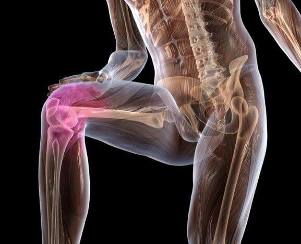Osteoarthritis is a chronic disease in which the structure of the connective tissues of the musculoskeletal system is damaged. The disease is characterized by a progressive course against the background of the gradual destruction of cartilage tissue. This pathology is diagnosed in many people over the age of 65, because one of the factors that cause this condition is the natural aging process of the body.
Description of the disease
Post-traumatic, endocrine and inflammatory diseases, excessive physical activity or, conversely, inactivity can lead to the development of degenerative-dystrophic disease. The main symptoms of osteoarthritis: pain in the joint area with edema and limited activity.
They use instrumental methods to diagnose the disease - X-rays, arthroscopy, CT and MRI. Conservative methods are used in the treatment of stage 1 and 2 osteoarthritis - medication, physiotherapy, massage and physiotherapy exercises. If irreversible destructive changes occur in the articular tissue, surgery is required - arthrodesis or endoprosthesis.
Pathogenesis
Osteoarthritis is characterized by obvious changes in the structure of connective tissue. Deformation erosions occur in cartilage, which destroys collagen fibers and proteoglycans containing protein (5-10%) and glycosaminoglycans (90-95%).
As a result, the stability of the collagen network is reduced, metalloproteinase is released, and all protein forms in the extracellular matrix are destroyed. Acceleration of destruction occurs due to increased biosynthesis of collagenases and stromelysis.
As a rule, enzymes control the level of cytokines - small peptide information molecules - when they are present in normal amounts in the body. If osteoarthritis develops, the concentration of this protein decreases, because a large amount of enzymes that affect cartilage are released.
As a result, proteoglycans, which have a distorted structure, absorb water that they cannot retain. For this reason, excess fluid penetrates the collagen fiber, which begins to "swell", which leads to a loss of strength and elasticity.
The qualitative and quantitative composition of the combined fluid is also subject to negative changes. Against the background of osteoarthritis, a decrease in the concentration of hyaluronic acid is observed. Hyaline stops the transport of nutrients and oxygen to the cartilage tissue, the amount needed for regeneration. Softened foci appear in the cartilage, followed by cracks, specific necrotic growths. Then the bare heads begin to be exposed, visible microtrauma against the background of displacement relative to each other.
What causes the disease to develop
Why does primary (idiopathic) osteoarthritis develop? Such a disease develops without the influence of any factor, so doctors believe that the cause of such a problem is genetically predisposed to early destructive processes in cartilage. The development of secondary osteoarthritis occurs as a complication of other joint diseases or against the background of injury.
The presence of the following can lead to degenerative-dystrophic pathology:

- located near the connective tissue structure in the form of damage to the joint tissue or fracture, dislocation, meniscus trauma, complete separation of muscle and connective tissue, tendons from the bone;
- congenital dysplastic disease in the development of joints;
- disorders of the endocrine system, metabolic diseases;
- rheumatism or rheumatic fever;
- polyarthritis, rheumatoid, reactive, metabolic, gout or psoriatic arthritis;
- cause purulent arthritis caused by streptococcus, epidermal or Staphylococcus aureus;
- tuberculosis, brucellosis, chlamydia, gonorrhea, syphilis anywhere;
- degenerative-dystrophic pathologies, such as osteochondritis dissections.
The increased mobility of joint tissue observed against the background of the production of special collagen fibers in the body can contribute to the formation of osteoarthritis.A similar phenomenon is observed in 10% of people living on the planet, it is not considered a disease.Against the background of hypermobility, there is a weakness in the tendon-ligament system that causes damage to a person, especially in the ankle joint, in the form of twisting and tearing of the connective tissue.
In some cases, problems with hematopoietic function (eg, hemophilia) can lead to osteoarthritis. Against the background of hemarthrosis (bleeding into the joint cavity), the blood supply to the cartilage tissue deteriorates, so it begins to collapse.
Among the predisposing factors should be the presence of old age, excessive load on the joint tissue, excessive body weight, operations performed, hypothermia.
The risk group includes menopausal women, people living in adverse environmental conditions, or people who have been exposed to toxic chemicals. If there are enough vitamins and minerals in the diet, the conditions for the gradual destruction of hyaluronic cartilage tissue arise.
symptoms

Osteoarthritis is dangerous because the first stage of formation is asymptomatic. Manifestation of the clinical picture of the disease occurs over time, the main symptoms appear with significant destruction of cartilage.At first, the patient feels a mild pain syndrome without a clear localization.Occurs after physical exertion - lifting heavy objects, sports training.
In some cases, the first sign of a person is the appearance of bruising and clicks when the joints bend or stretch. The patient sometimes finds it difficult to walk. In the early stages of osteoarthritis, mobility problems appear only in the morning and pass quickly.
With the further development of the pathology, painful sensations become disturbed due to impaired sleep at night, and chronic fatigue develops. When the disease reaches 2 degrees, the intensity of pain increases against the background of changes in weather conditions, exacerbation of chronic diseases, acute respiratory viral infections.
Physical activity is significantly reduced. Thinning of the cartilage tissue and deliberate restriction of movement to prevent the patient's pain impede mobility. This increases the load on the tissue of the opposite joint, which contributes to further destruction.
Arthrosis is characterized by other specific features:
- pain that causes spasm in skeletal muscles and muscle contracture (limited passive motor function of the joint);
- squeaks in the joint tissue, clicks, squeaks during the movement of a stable nature, occurs when the bones move relative to each other;
- frequent painful muscle cramps;
- deformation of joints causing posture and gait disorders;
- Deformation characterized by a significant reduction or complete absence of motor activity in the background of grade 3 osteoarthritis to the curvature of the joints.
If arthrosis has developed in the knee, ankle, or hip joint before stage 3, the person should use a cane or crutch when moving.
If you don't start treatment on time, the disease will start to progress, relapses will start to bother you on a regular basis, and over time, exacerbations will become more frequent. In the morning, the hardness does not last long, it gradually becomes permanent.
When examining a person with stage 1 osteoarthritis, the doctor sees only a slight edema of the joint tissue with complete protection of motor function. Stage 2 of the disease manifests itself with pain and slight deformity on palpation. Bone thickening occurs near the test cavity.
Arthrosis is characterized by the formation of synovitis - inflammation of the synovium in the hip, ankle, knee or shoulder joint. The main symptom of this disease is the development of a round seal near the joint, you can feel how the fluid moves when you press it. With acute synovitis, the temperature can rise to 37-38 degrees, headaches and digestive problems can occur.

Diagnostic measures
The disease is determined on the basis of instrumental methods, clinical features, anamnestic data, patient complaints based on the results of the study. In this case, a clinical study of blood and urine is not very informative - if the cause of osteoarthritis is not related to metabolic problems, all indicators remain normal.
If synovitis develops, there is an increase in the rate of erythrocyte sedimentation rate (up to 30 mm / s), an increase in leukocytes and fibrinogen in the bloodstream.This indicates the presence of acute or chronic inflammation in the body.Biochemical and immunological parameters change with secondary arthrosis.
The most informative way to detect degenerative-dystrophic diseases is radiography in 2 projections (lateral and straight).
X-rays show osteoarthritis as follows:
- There are no radiological signs at the initial stage.
- In the first stage, it appears as a pathological, indeterminate, uneven narrowing of the joint space. The edges of the bone plates are slightly flattened, initial osteophytes are formed (sometimes absent).
- In the second stage, the picture shows an image in the form of an obvious narrowing of the joint space, which is 2-3 times more than normal. Osteophytes are formed in large numbers, the formation of subchondral osteosclerosis is noted. Awareness as a cyst appears in the appendages.
- In the third stage, the picture shows open subchondral osteosclerosis and large marginal osteophytes. The junction area has narrowed significantly.
- In the fourth stage, coarse-grained osteophytes are formed, the joint space is almost completely melted, and the bone attachments that make up the joint are deformed and compressed.
After examining the X-ray images, if the doctor suspects a diagnosis, the patient is prescribed a computed tomography. An MRI is performed to assess the condition of the connective tissue near the joint. The use of a contrast agent allows you to monitor the dynamics of how the tissues are supplied with blood, to determine the degree of inflammation in the synovitis.

Treatment of osteoarthritis
At present, it is impossible to completely cure osteoarthritis, because there are no pharmacological substances that restore cartilage tissue.The main purpose of treatment is to prevent further development of the disease, to ensure the mobility of the joints.Therapy for osteoarthritis is long, complex, and involves the use of topical and systemic medications.
Patients should not overload the joints; It is necessary to limit motor activity with the help of orthopedic devices - orthoses, elastic bandages. Overweight people need to adjust their diet to lose weight over time and start a diet.
When there is a stable remission, the patient should do therapeutic gymnastics every day. First you have to do it under the supervision of a specialist, and in the future you have to do gymnastics at home yourself. In addition to physical therapy, you can go to the pool, do yoga or ride a bike.
To reduce the intensity of pain, the use of drugs belonging to different pharmacological groups is prescribed:
- Tablets are non-steroidal anti-inflammatory drugs, ointments, solutions for intravenous injection.
- Intraarticular injections of anesthetics with the addition of glucocorticosteroids.
- Muscle relaxant to relieve muscle spasms and contractures.
In addition, the treatment of osteoarthritis includes the use of B vitamins, if necessary, sedatives - antidepressants and tranquilizers. It is mandatory to prescribe chondroprotectors in the form of a long course.Means of this group help to partially restore cartilage.
To increase the clinical activity of joint tissue, it is necessary to carry out physiotherapeutic procedures - laser therapy, magnetotherapy, UHF.
Painful manifestations in the joints should be a reason to see a doctor immediately. Treatment in the early stages of the development of osteoarthritis allows you to stop the destructive processes in cartilage, prevent disability and disability.

























